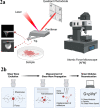Biological role of matrix stiffness in tumor growth and treatment
- PMID: 36419159
- PMCID: PMC9682678
- DOI: 10.1186/s12967-022-03768-y
Biological role of matrix stiffness in tumor growth and treatment
Abstract
In recent years, the biological role of changes in physical factors in carcinogenesis and progression has attracted increasing attention. Matrix stiffness, also known as ECM stress, is a critical physical factor of tumor microenvironment and remains alternating during carcinogenesis as a result of ECM remodeling through activation of cancer-associated fibroblasts and extracellular collagen accumulation, crosslinking and fibrosis. Different content and density of extracellular collagen in ECM endows matrix with varying stiffness. Physical signals induced by matrix stiffness are transmitted to tumor cells primarily by the integrins receptor family and trigger a series of mechanotransduction that result in changes in tumor cell morphology, proliferative capacity, and invasive ability. Importantly, accumulating evidence revealed that changes in matrix stiffness in tumor tissues greatly control the sensitivity of tumor cells in response to chemotherapy, radiotherapy, and immunotherapy through integrin signaling, YAP signaling, and related signaling pathways. Here, the present review analyzes the current research advances on matrix stiffness and tumor cell behavior with a view to contributing to tumor cell growth and treatment, with the hope of improving the understanding of the biological role of matrix stiffness in tumors.
Keywords: Apoptosis; Cancer therapy; Cell proliferation; Matrix stiffness.
© 2022. This is a U.S. Government work and not under copyright protection in the US; foreign copyright protection may apply.
Conflict of interest statement
The authors declare that they have no competing interests.
Figures


References
-
- Fu R, Zhang YW, Li HM, Lv WC, Zhao L, Guo QL, et al. LW106, a novel indoleamine 2,3-dioxygenase 1 inhibitor, suppresses tumour progression by limiting stroma-immune crosstalk and cancer stem cell enrichment in tumour micro-environment. Br J Pharmacol. 2018;175(14):3034–3049. doi: 10.1111/bph.14351. - DOI - PMC - PubMed
Publication types
MeSH terms
Substances
LinkOut - more resources
Full Text Sources
Medical

